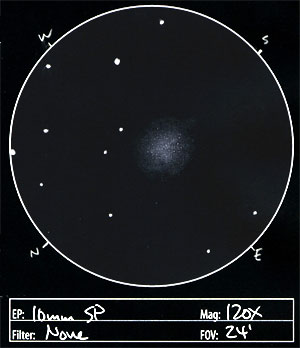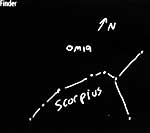
Observation Notes:
 M19 was large and loose. Granularity appeared with averted vision. The core, while soft, hand an irregular shape with an arc running northwest to south, and an extension to the east.
M19 was large and loose. Granularity appeared with averted vision. The core, while soft, hand an irregular shape with an arc running northwest to south, and an extension to the east.
Factoids:
M19 is the most elliptical globular cluster. This may be due to its proximity to the galactic center of 5200 light years, and the tidal forces this generates. It lies 28,000 light years away and is receding from us at 146 km/sec. Its diameter of 17' corresponds to 140 light years across along its major axis.
M62 was discovered by Charles Messier in 1764. It was first resolved into stars by William Herschel.
| Subject | M19 (NGC 6273) | |
| Classification | Globular Cluster (Class VIII) | |
| Position* | Ophiuchus [RA: 17:02:36 / Dec: -26:16:00] | |
| Size* | 17.0' | |
| Brightness* | 6.8 | |
| Date/Time | October 2, 2005 - 7:55 PM (October 3, 2005 - 02:55 UT) | |
| Observing Loc. | Flagstaff, AZ - Home | |
| Instrument | Orion SVP 6LT Reflector (150 mm dia./1200 mm F/L) | |
| Eyepieces/Mag. | 10 mm (120X) | |
| Conditions | Clear, breezy | |
| Seeing | ~4-5/10 | |
| Transparency | Mag 4.3 NELM (based on Nu-Serpentis) | |
| Sources | SEDS |
*Based on published data.




